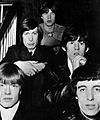Throwing Stones III: Write Yer Own
(For Part II, click Throwing Stones II: If You Sign Me Up.)
Part II covered the rise of the Rolling Stones and their PR whiz kid manager, Andrew Loog Oldham, along with the band’s branding as the anti-Beatles. But when the time came to record their crucial second single, the Stones found themselves without a song.
 Andrew Loog Oldham is bipolar, and had become depressed over the Stones’ lack of new material well before the session. Dejected, Oldham excused himself and took a brief walk, desperately trying to think of a solution. In perhaps the most incredible stroke of luck in pop music history, he bumped into John Lennon and Paul McCartney. The two songwriters stepped out of a handsome cab, having just left a Variety Club Luncheon honoring the Beatles. Full of free booze and good cheer, they immediately sensed their friend’s distress. When Oldham explained his dilemma, they responded with what can only be called Beatlesque enthusiasm. No song? No problem! They had a new number that was perfect for the Stones!
Andrew Loog Oldham is bipolar, and had become depressed over the Stones’ lack of new material well before the session. Dejected, Oldham excused himself and took a brief walk, desperately trying to think of a solution. In perhaps the most incredible stroke of luck in pop music history, he bumped into John Lennon and Paul McCartney. The two songwriters stepped out of a handsome cab, having just left a Variety Club Luncheon honoring the Beatles. Full of free booze and good cheer, they immediately sensed their friend’s distress. When Oldham explained his dilemma, they responded with what can only be called Beatlesque enthusiasm. No song? No problem! They had a new number that was perfect for the Stones!
Lennon, McCartney and Oldham strolled back to the session. John and Paul decided their new tune needed a bridge, and knocked one out in no time. The two Beatles taught the Stones the song and were on their merry way. They had been there less than half an hour. The Stones were astounded.
It seems counterintuitive that the Beatles wrote the anti-Beatles’ first top twenty hit. But it made perfect sense. While “I Wanna Be Your Man” lacked Lennon and McCartney’s characteristic melodic inventiveness, it was loaded with rhythmic drive. That made it an ideal vehicle for the young Stones, and let the band to capitalize on fresh material from England’s hottest hitmakers. The song reached number 12 on the British charts. The Stones were rolling again.
Yet the last-minute save only deepened Oldham’s sense of doom. The odds of two Beatles appearing deus ex machina (literally!) to save the day a second time were nil. There was only one solution: Someone in the Rolling Stones had to start writing songs.
 Oldham figured if Lennon and McCartney could write hits, so could Jagger and Richard(s). He floated the idea. Mick and Keith torpedoed it. They were performers, not song poets. Oldham pressed the issue. Bands that couldn’t come up with original material had no future. And they certainly couldn’t expect the petulant and increasingly unreliable Brian Jones to deliver. If the Rolling Stones wanted to hang onto their newfound fame, Jagger and Richards had better get started. The reluctant duo eventually agreed, but made little progress.
Oldham figured if Lennon and McCartney could write hits, so could Jagger and Richard(s). He floated the idea. Mick and Keith torpedoed it. They were performers, not song poets. Oldham pressed the issue. Bands that couldn’t come up with original material had no future. And they certainly couldn’t expect the petulant and increasingly unreliable Brian Jones to deliver. If the Rolling Stones wanted to hang onto their newfound fame, Jagger and Richards had better get started. The reluctant duo eventually agreed, but made little progress.
The ever-dramatic Oldham came up with a typically over-the-top solution. He locked the singer and the guitarist in a room and told them they could come out as soon as they had a new song to play.
According to Oldham and Richards, they didn’t finish until dawn. The title they came up with was “As Time Goes By.” While that’s exactly the choice of subject matter you would expect from two guys you’d locked in a kitchen all night, it’s also the title of the classic song in the classic movie “Casablanca.” Oldham changed the title to “As Tears Go By,” cleaned up the structure, and polished the lyrics with help from his friend Lionel Bart, who had penned chart-toppers for British teen idols like Cliff Richard before moving on to the hit musical “Oliver!”
Jagger and Richards were somewhat embarrassed by “Tears,” which they felt was far too lightweight for the tough, bluesy Stones. That was fine with Oldham. He gave the song to his latest discovery, seventeen-year-old Marianne Faithful. After meeting Faithful at a party, Oldham took the inexperienced ingénue into the studio, where he lived out his Phil Spector fantasy to the string-soaked hilt. The result was a smash, reaching number 9 on the English chart and 22 in America. As soon as Jagger and Richard’s started receiving king-sized royalty checks, they realized Oldham had been right all along. Songwriting was the way to go.
Like Lennon and McCartney, the Jagger-Richards songwriting team got great fast. Their writing developed with astonishing speed, and quickly created the foundation of their band’s long-term success. And I don’t use the term “their band” lightly. The moment Jagger and Richards became the source of the band’s material, they became both the lifeblood and the leaders of the Rolling Stones.
The power shift hit Brian Jones like a bolt out of the blues. Jones had put the Stones together, named the band and led it since day one. He had a remarkable knack for adding just the right touch to the Stone’s records (the slide guitar lick on “The Last Time,” the sitar licks on “Paint It Black,” the marimba line on “Under My Thumb”), but was incapable of finishing a song–by himself or with a collaborator. As his authority slipped away, Jones comforted himself by upping his already alarming drug intake.
 While Jagger and Richards were busy writing songs, Andrew Loog Oldham was busy writing prose. Oldham’s PR masterpiece was the soon-to-be-infamous line, “Would You Let Your Daughter Go With A Rolling Stone?” Oldham fed his grabber to Melody Maker magazine, where a teen-centric editor changed “Daughter” to “Sister” and ran it as a headline. The stuffy Fleet Street editors who ruled the mainstream press weren’t exactly sure what “Go” implied, so they changed it to “Would You Let Your Daughter Marry A Rolling Stone?” and turned it into a legend. “The headline was a great example of everlasting meaning via product placement,” Oldham would write, decades later.
While Jagger and Richards were busy writing songs, Andrew Loog Oldham was busy writing prose. Oldham’s PR masterpiece was the soon-to-be-infamous line, “Would You Let Your Daughter Go With A Rolling Stone?” Oldham fed his grabber to Melody Maker magazine, where a teen-centric editor changed “Daughter” to “Sister” and ran it as a headline. The stuffy Fleet Street editors who ruled the mainstream press weren’t exactly sure what “Go” implied, so they changed it to “Would You Let Your Daughter Marry A Rolling Stone?” and turned it into a legend. “The headline was a great example of everlasting meaning via product placement,” Oldham would write, decades later.
It’s hard to explain just how small the media world was in the 1950s and ’60s, or how easy it was to ignite a public uproar. Righteous indignation poured forth over an endless series of “outrages” that seem laughably quaint and incredibly non-newsworthy by today’s standards. Blue jeans, comic books, fast cars, television and rock ’n’ roll had all served time in the pop cultural hot seat as the great corruptor of modern youth. Now it was the Rolling Stones turn.
(This concludes Part III. Click Throwing Stones IV: The Unmanageable Manager to read Part IV.)
Chris L.
WOW! Never knew the dynamic duo helped out the Stones. Great read! Now I have mixed feelings about them… Oh, no.
Oh, no.
Hugh K.
The Strolling Bones were once little British babies? Ah heck, I still love ‘em. But what a story!
Ed P.
Very interesting; well written. Last time I saw the Stones on that Scorcese film they really sucked, IMO. Bad. Or maybe the sound wasn’t synced to the picture. Yeah, that must have been it.
Elvis W.
I’d be curious what you think about the Kinks positioning themselves during this era in music. I’ve never been much of a Beatles fan (so sue me), but I’d say the Kinks “did it” for me. The Stones were alway there, of course. I wonder where Brian Jones would be musically if he were still alive today… Memphis or Manchester? Nice perspective on the Stones in your trilogy!
Bill
The early Kinks were a curious and combustible combination. Ray Davies presented himself onstage as an androgynous dandy, and his songs grew increasingly lyrically sophisticated in almost no time. Brother Dave, with his aggressive, slashing, power chord guitar attack, was really England’s first punk rocker. So, a difficult act to position from a marketing standpoint. How ’bout, “The Kinks: Two Bands For The Price Of One!”
Shully
I really enjoy your branding blogs. They’re very cleverly written–and a lot more accurate than my memory. Keep “feeding the beast” and before you know it you’ll turn your music and advertising knowledge into a best-selling book. I’ll buy the first copy.